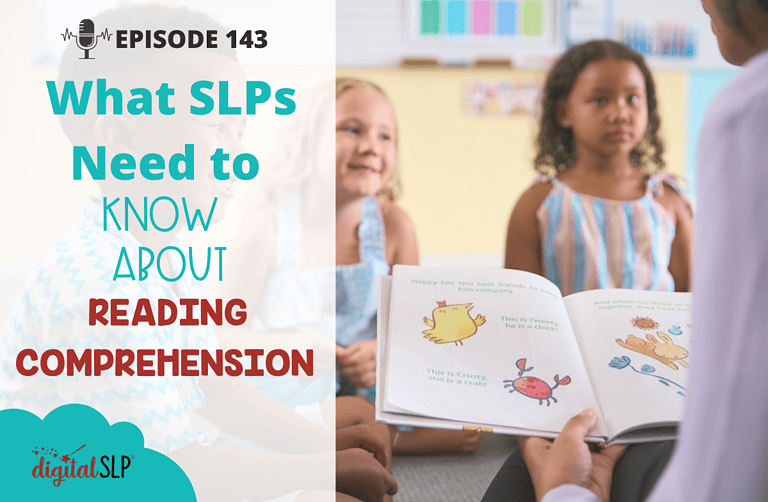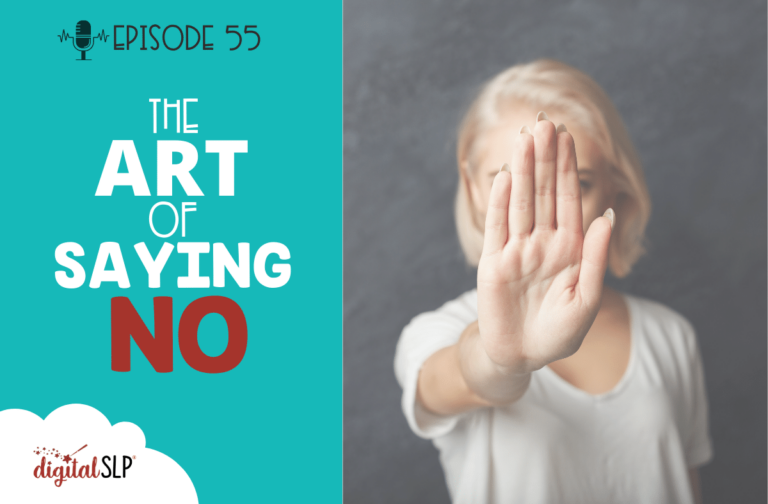In this episode, I talk about the best advice for teletherapists. There’s a lot of information and resources regarding teletherapy, so today’s episode highlights some of the essential core recommendations to keep in mind.
Maximize your technology
It is recommended that new teletherapists make sure their computer meets the minimum requirements and has a strong internet connection. Headphones are suggested for improved therapy quality, and knowing your therapy platform is crucial. Experienced teletherapists should learn to troubleshoot common issues and create a document for students and families with troubleshooting tips.
Connections
The first core principle of teletherapy is connection. As SLPs, I think we all know that building rapport with our students and clients is so important. With teletherapy, it’s even MORE important, since we’re not physically in the room with them. We really need to develop that trust and that positive relationship.
Three core principles that apply to every session: 1) make a personal connection with your students, 2) create a sense of structure and routine, and 3) incorporate play and fun into sessions.
Creativity
The following fundamental principle is centered on creativity. Take a moment to reflect on your distinctive qualities as a therapist and the skills you bring to your sessions. You could even consider brainstorming a list after finishing this episode. Once you have re-familiarized yourself with your strengths, endeavor to be imaginative and infuse them into your therapy sessions as much as possible.
Compassion
We should not undermine the importance of compassion as a core principle for teletherapists when working with clients and families, as well as for themselves. Prioritizing compassion in therapeutic interactions can change the experience and help to reduce stress. It’s essential to recognize that most people are doing their best at any given moment. When things go wrong, teletherapists should practice self-compassion and acknowledge that they are doing their best.
References and Resources:
- Biggs, E. E., Therrien, M. C. S., Douglas, S. N., & Snodgrass, M. R. (2022).
- Augmentative and alternative communication telepractice during the COVID-19 pandemic: A national survey of speech-language pathologists.
- American Journal of Speech-Language Pathology, 31(1), 303–321.
- https://doi.org/10.1044/2021_AJSLP-21-00036
- From 0 to 60: Telepractice Lessons Learned
- Hall-Mills, S., Johnson, L., Gross, M., Latham, D., & Everhart, N. (2021).
- Providing telepractice in schools during a pandemic: The experiences and perspectives of speech-language pathologists. Language, Speech, and Hearing Services in Schools, 1–17.
- https://doi.org/10.1044/2021_LSHSS-21-00023
- My Teletherapy Room
- Podcast Episode: Teletherapy 101
- Podcast Episode: Teletherapy Tips for SLPs
- Podcast: Top Equipment Recommendations for Teletherapy
- *Editing note: This is a link to the podcast text draft on Basecamp. Please update this link when the podcast is published.
- Smith, S., Parafiniuk, D., & Martin, D. (2021). 20Q: Teletherapy Basics: Tips & Tricks for School-Age Children. SpeechPathology.com. Article 20423. Available from www.speechpathology.com
- Zoom System Requirements
- To sign up for a 7-day free trial, please check out: https://www.thedigitalslp.com/digitalslp/
Full Transcript of Podcast: Best Advice for Teletherapists
Episode 107 - Best Advice for Teletherapists
Welcome back to another episode of the Speech Space Podcast, a podcast full of tips and resources for SLPs. I'm your host, Jessica Cassity, and this is Episode 107.
Today, we're going to be talking about the best advice for teletherapists. Now, before we get started, I did want to mention that this podcast is brought to you by The Digital SLP membership site, which is a site that features time-saving interactive digital resources that are all teletherapy platform-friendly. You can learn more or sign up by going to thedigitalslp.com/digitalslp.
Now, this definitely is not the first time that we've talked about teletherapy on the podcast, but I am so passionate about using digital tools for SLPs, and of course, that includes teletherapy. I love to share resources and ideas that are designed to support teletherapists, and honestly, I really just love talking about the topic of teletherapy on the podcast. It could get overwhelming if I listed all of our past blog posts and podcast episodes that are related to teletherapy. So you might just want to go to thedigitalslp.com/blog or thedigitalslp.com/podcast, and just browse through the options that way. I can put some of our favorite articles related to teletherapy in the show notes, though, just to get you started.
I will take a moment right now just to highlight two previous podcast episodes that go in-depth about teletherapy. Now, the first one is called Teletherapy 101. This episode was recorded right when the schools were first switching to teletherapy services at the beginning of the pandemic, and many SLPs were feeling extremely overwhelmed. So, it's especially relevant if you are new to teletherapy. The second episode that I recommend checking out is from September of 2020, so it goes a little ways back, and this episode includes in-depth ideas and resources to check out related to teletherapy.
You know, we're in a unique period now in terms of teletherapy, because quite a few of us do have some teletherapy experience at this point, but we might not feel completely comfortable with it. And there might also be some new grads out there who are listening and thinking about teletherapy, or maybe some SLPs who have been in the medical setting who want to switch over and give it a try. So I'm sure there are still some teletherapy beginners in need of support.
There's a lot of information and so many resources floating around when it comes to teletherapy, so the idea of today's episode is really just to highlight some of the most important core recommendations to keep in mind. Basically, we're going to cover the best teletherapy advice I've ever heard. So, let's go ahead and get started.
Every time I talk to an experienced teletherapist and ask them for their best teletherapy advice, the answer is the same. They always mention the importance of maximizing your technology. This is what makes teletherapy unique. We really can't provide effective therapy if the technology is not working. Obviously, the therapist and the therapeutic relationship are still of primary importance, but with teletherapy, technology is what makes the therapeutic relationship possible. Maximizing your use of technology could mean different things depending on where you are on your journey with teletherapy.
Let's start by addressing technology for very new teletherapists. You're going to want to make sure that your computer's operating system can handle teleconferencing and that it meets the minimum processor and RAM requirements. This might vary depending on what platform you're using, but I'll link a resource page with requirements for Zoom in the show notes, just as an example.
You'll also need a strong internet connection with sufficient bandwidth, and this is covered on the Zoom resource page as well. I always recommend wiring your computer directly into your router for teletherapy rather than using Wi-Fi. This way, your connection won't be affected by things like weather issues or network traffic. You'll also need to make sure your students or clients can see and hear you clearly. In early 2022, ASHA published a research paper about the experience of school-based SLPs providing teletherapy during the pandemic. They found that audio issues were some of the greatest sources of frustration throughout that whole experience, so this is definitely something to be really mindful of. It's possible to do speech therapy without headphones, but I think the quality of therapy is greatly improved with headphones, so I would definitely suggest at least giving them a try.
The next element of maximizing your technology is relevant for both new and experienced teletherapists, and that's knowing your therapy platform, whether it's Zoom or a platform designed especially for teletherapy. Usually the platforms offer training and webinars to help you learn the basics, and YouTube can be another great source of tips and tutorials for specific platforms. This is incredibly important because it will allow you to focus on your student rather than being distracted by trying to figure out how to share your screen or something like that. Being an expert about your platform also allows you to support your client on the other side of the screen who likely doesn't know as much about the platform as you do.
This brings me to the next technology recommendation, which is probably more relevant for experienced teletherapists, and that is learning how to troubleshoot issues that come up, and explain possible solutions to your clients. When you've been doing teletherapy for a while, you'll start to notice the challenges that come up over and over again, and you'll also start to figure out how to fix them, even if that involves a lot of trial and error at first. You may even want to create a document for yourself and your students and families that has troubleshooting tips for common issues.
You know, I feel like I could talk about technology for teletherapy all day, but I'm trying to stick to the most important advice, so I'm gonna go ahead and move on to the next one, which is the connection. Now, just to be clear, I am not talking about the Internet connection. I am talking about your actual connection with your student or client on the other screen during or the other end of a teletherapy session. The rest of this episode is going to be less about the nuts and bolts tips, but more about three core principles that apply to every teletherapist. It just happened to work out that each of these principles starts with C, so these will be your CCCs for teletherapy!
The first core principle of teletherapy is connection. As SLPs, I think that we all know that building rapport with our students and clients is so important. With teletherapy, it's even more important, since we're not physically in the room with them, we really need to develop that trust and that positive relationship. It's absolutely worth it to spend a little bit of extra time, especially with a new student, to make sure that they're feeling safe and connected. We can also recognize some of the connection benefits that come with teletherapy. For example, as we start to learn what students are interested in and what they really care about, technology makes it easy to build our sessions around the topics that get them really engaged. Teletherapy also makes it easier to connect with the families of our students and our clients. We usually have more opportunities to have quick chats with parents and with our younger clients. The parents might be active participants in the session. This is also great for coaching and carryover, and it builds the parents' confidence in the work that we're doing together.
The next core principle is creativity. Step back and think about what makes you unique as a therapist and what strengths you bring to the table. You may even want to spend some time brainstorming a list after this episode is over. And once you've really reminded yourself about your strengths, try to get creative and incorporate them into therapy as much as possible. For example, maybe you're artistic, so you begin including some simple art projects in your speech therapy sessions, or you share some of your art with your students and encourage them to describe what they see. Maybe you are into music, so you make an effort to bring songs into your sessions, or maybe you practice yoga, so you incorporate movement into your sessions. Maybe you like to be silly, so you wear funny costumes and use lots of puppets in your sessions. There's no wrong answer here. The idea is really just to embrace your own unique creativity and find ways to naturally infuse it into your speech therapy sessions.
Another way to think about the principle of creativity is to consider trying out tools that weren't necessarily designed for speech therapy in your sessions. These could be zoo or aquarium, live webcams, TED Talks, cooking shows, sports clips. I mean, the possibilities are really endless. Whenever you encounter a kid-friendly video or game or article, you can challenge yourself to think about how you might use it in teletherapy. You can also find creativity in simplicity. Just as an example, I think it would be a fun challenge to plan a great therapy session using the built-in Zoom features and no additional materials. You can get a lot of language from virtual backgrounds, filters, and stickers.
Let's go ahead and move on to the final core principle we're going to talk about today, which is compassion. I think that the best possible advice a teletherapist could ever receive is to have compassion, both for the clients and the families we work with and for ourselves. I'm not going to pretend that it's always easy to be compassionate, but when we prioritize compassion in our therapeutic interactions, it can change our whole experience. We can recognize that most people are doing the best that they can at any moment, which makes it a little less stressful when parents are upset with this or students are having trouble staying at the computer. The principal is the same when we apply it to ourselves. One of the most challenging aspects of teletherapy is that it does include so many factors that are outside of our control, especially when it comes to technology on the student side. Instead of getting lost in self-criticism when things go wrong, we can direct compassion towards ourselves and acknowledge that we are doing our very best and we have so much to offer even on the really difficult days.
(11:39)
So that is it for today's episode. If you enjoyed it, I would be so grateful if you would just take a moment to leave a five star review to make it easier for our fellow SLPs to find this show. We released new episodes twice a month on the the first and third Tuesdays. And also don't forget to check out thedigitalslp.com/digitalslp if you are interested in signing up for the membership or for a free trial. Thank you so much for listening!













Recent Comments